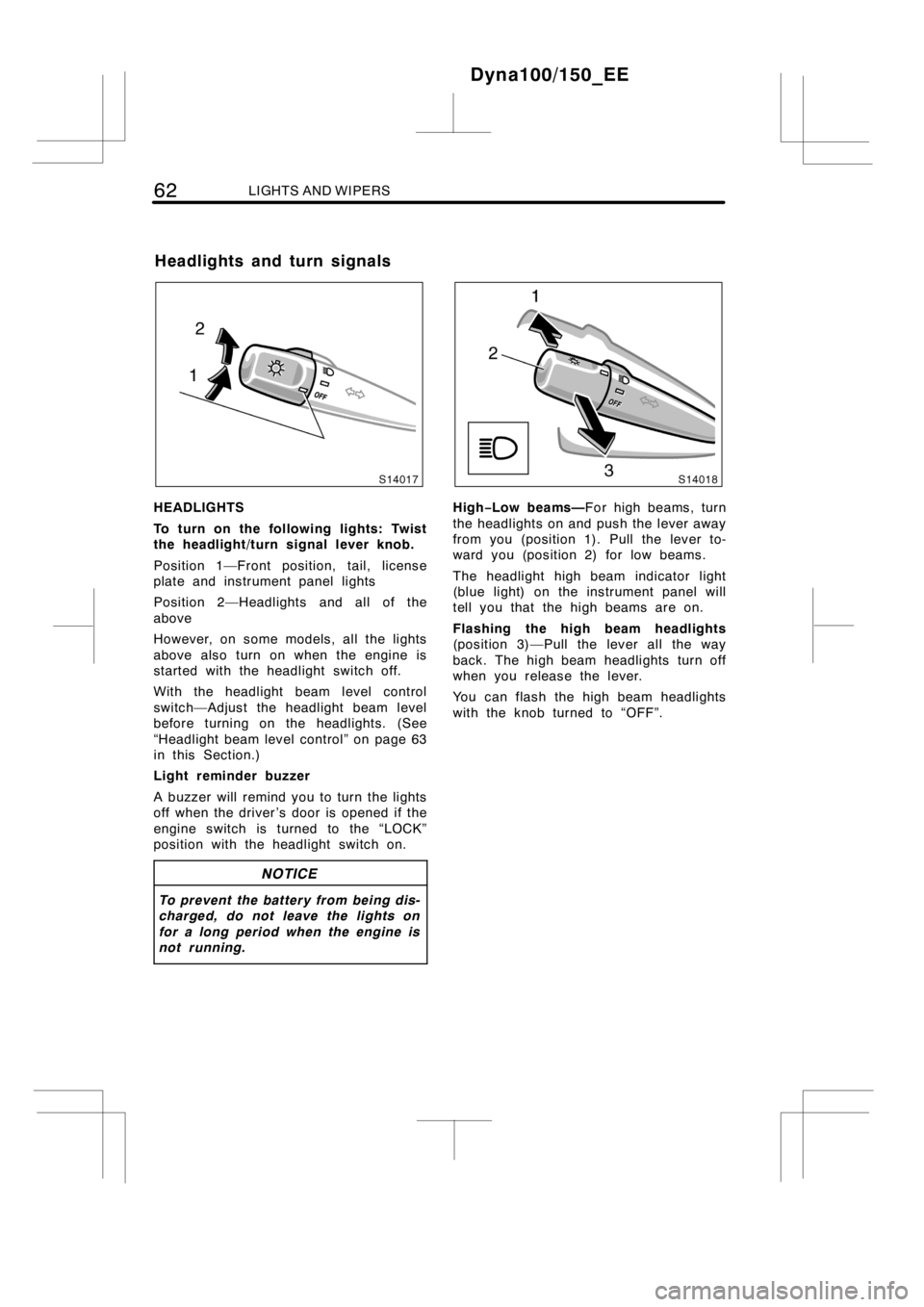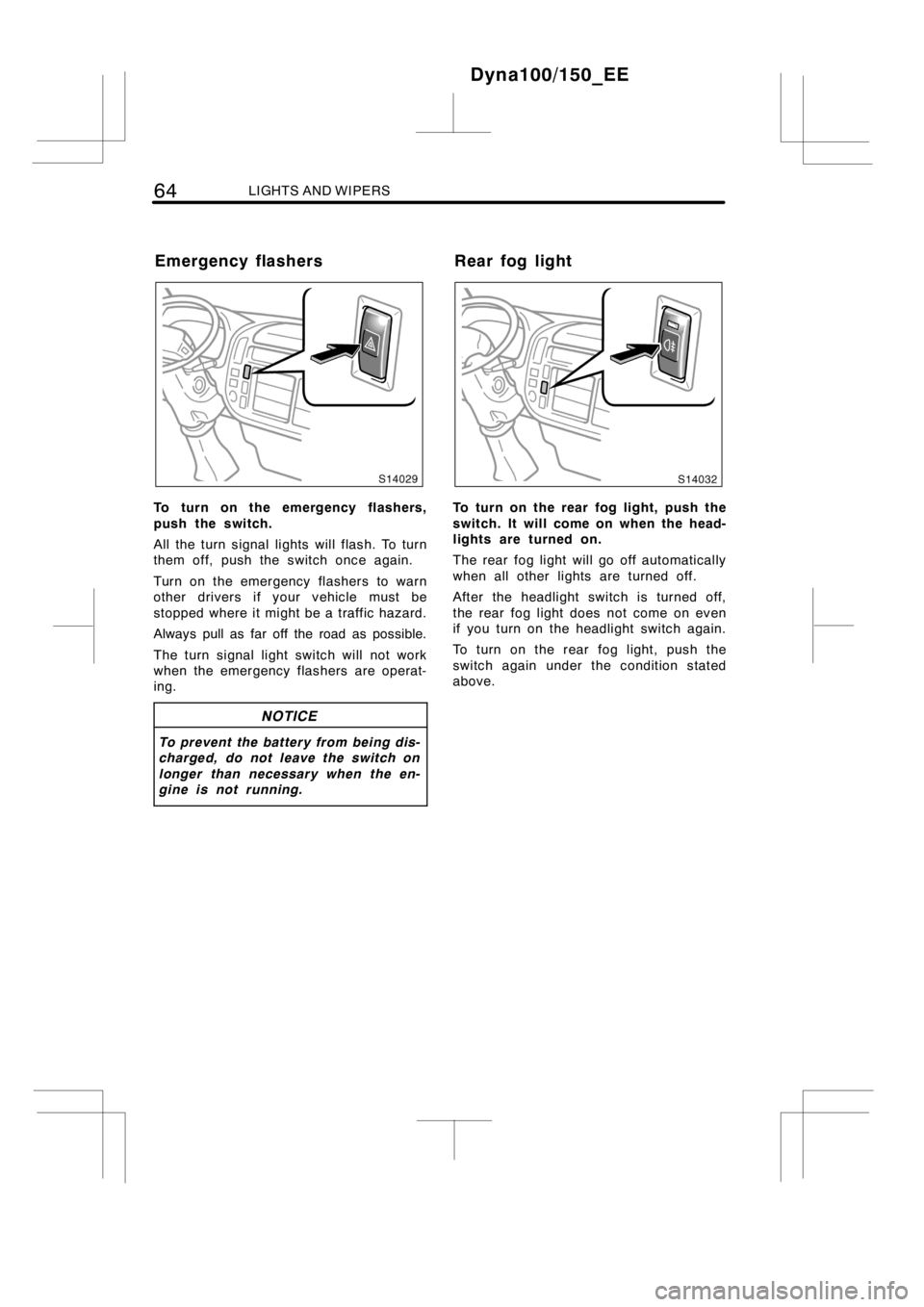2014 TOYOTA DYNA 100/150 battery
[x] Cancel search: batteryPage 68 of 232

62LIGHTS AND WIPERS
HEADLIGHTS
To turn on the following lights: Twist
the headlight/turn signal lever knob.
Position 1—Front position, tail, license
plate and instrument panel lights
Position 2—Headlights and all of the
above
However, on some models, all the lights
above also turn on when the engine is
started with the headlight switch off.
With the headlight beam level control
switch—Adjust the headlight beam level
before turning on the headlights. (See
“Headlight beam level control” on page 63
in this Section.)
Light reminder buzzer
A buzzer will remind you to turn the lights
off when the driver ’s door is opened if the
engine switch is turned to the “LOCK”
position with the headlight switch on.
NOTICE
To prevent the battery from being dis-
charged, do not leave the lights on
for a long period when the engine is
not running.
High−Low beams—For high beams, turn
the headlights on and push the lever away
from you (position 1). Pull the lever to-
ward you (position 2) for low beams.
The headlight high beam indicator light
(blue light) on the instrument panel will
tell you that the high beams are on.
Flashing the high beam headlights
(position 3)—Pull the lever all the way
back. The high beam headlights turn off
when you release the lever.
You can flash the high beam headlights
with the knob turned to “OFF”.
Dyna100/150_EE
Headlights and turn signals
Page 70 of 232

64LIGHTS AND WIPERS
To turn on the emergency flashers,
push the switch.
All the turn signal lights will flash. To turn
them off, push the switch once again.
Turn on the emergency flashers to warn
other drivers if your vehicle must be
stopped where it might be a traffic hazard.
Always pull as far off the road as possible.
The turn signal light switch will not work
when the emergency flashers are operat-
ing.
NOTICE
To prevent the battery from being dis-
charged, do not leave the switch on
longer than necessary when the en-
gine is not running.
To turn on the rear fog light, push the
switch. It will come on when the head-
lights are turned on.
The rear fog light will go off automatically
when all other lights are turned off.
After the headlight switch is turned off,
the rear fog light does not come on even
if you turn on the headlight switch again.
To turn on the rear fog light, push the
switch again under the condition stated
above.
Dyna100/150_EE
Emergency flashers Rear fog light
Page 86 of 232

80ENGINE (IGNITION) SWITCH, TRANSMISSION AND PARKING BRAKE
“START”—Starter motor on. The key
will return to the “ON” position when
released.
For starting tips, see page 123 in Section
3.
“ON”—Engine on and all accessories
on. Before starting, glow plugs on and
engine preheated.
This is the normal driving position.
“ACC”—Accessories such as the radio
operate, but the engine is off.
“LOCK”—Engine is off and the steering
wheel is locked. The key can be re-
moved only at this position.
You must push in the key to turn the key
from “ACC” to the “LOCK” position.
When starting the engine, the key may
seem stuck at the “LOCK” position. To
free it, first be sure the key is pushed all
the way in, and then rock the steering
wheel slightly while turning the key gently.
It is not a malfunction if the needles on
all meters and gauges move slightly when
the engine switch is turned to the “ACC”,
“ON” or “START” position.
CAUTION
Never remove the key when the ve-
hicle is moving, as this will lock the
steering wheel and result in loss of
steering control.
NOTICE
Do not leave the engine switch in the
“ON” position if the engine is not
running. The battery will discharge.
Dyna100/150_EE
Engine (ignition) switch
Page 95 of 232

AIR CONDITIONING SYSTEM89
DTo cool off your Toyota after it has
been parked in the hot sun, drive with
the windows open for a few minutes.
This vents the hot air, allowing the air
conditioning to cool the interior more
quickly.
DMake sure the air intake grilles in front
of the windshield are not blocked (by
leaves or snow, for example).
DKeep the area under the front seats
clear to allow air to circulate through-
out the vehicle.
DOn cold days, set the fan speed to
high for a minute to help clear the
intake ducts of snow or moisture. This
can reduce the amount of fogging on
the windows.
DWhen driving on dusty roads, close all
windows. If dust thrown up by the ve-
hicle is still drawn into the vehicle after
closing the windows, it is recommended
that the air intake selector be set to
FRESH and the fan speed selector to
any setting except “OFF”.
DIf following another vehicle on a dusty
road, or driving in windy and dusty
conditions, it is recommended that the
air intake selector be temporarily set to
RECIRCULATE, which will close off the
outside passage and prevent outside
air and dust from entering the vehicle
interior.
DDuring use, various odors from inside
and outside the vehicle may enter into
and accumulate in the air conditioning
system. This may then causeodor to
be emitted from the vents.
DTo reduce potential odors from occur-
ring:
It is recommended that the air condi-
tioning system be set to outside air
mode prior to turning the vehicle off.
CAUTION
To prevent the windshield from fog-
ging up, do not select the windshield
air outlets during cool air operation
in extremely humid weather. The dif-
ference between the temperature of
the outside air and that of the wind-
shield can cause the outer surface of
the windshield to fog up, blocking
your vision.
NOTICE
To prevent battery discharge, do not
leave the air conditioning system on
longer than necessary when the en-
gine is stopped.
Heating
For best results, set controls to:
Fan speed—Any setting except “OFF”
Temperature—To w a r d sWARM
(red zone)
Air intake—FRESH(outside air)
Air flow—FLOOR
Air conditioning—OFF
DFor quick heating, set the temperature
selector lever to the right end position
and select recirculated air mode for a
few minutes. To keep the windows from
fogging after the vehicle interior has
been warmed, select fresh air mode.
DPress the “A/C” button on for dehumidi-
fied heating.
DChoose floor/windshield air flow to heat
the vehicle interior while defrosting the
windshield.
Dyna100/150_EE
Operating tips
Page 132 of 232

126STARTING AND DRIVING
After high−speed or extended driving that
requires a heavy engine load, the engine
should be allowed to idle, as shown in the
chart before turning it off.
Driving condition and required idling
time
Normal city driving
Idling time—Not necessary
High−speed driving
About 80 km/h (50 mph)
Idling time—About 20 seconds
About 100 km/h (62 mph)
Idling time—About 1 minute
Steep mountain slopes or continued
driving above 100 km/h (62 mph)
Idling time—About 2 minute
NOTICE
Do not turn the engine off immediate-
ly after a heavy load has been placed
on the engine in order to prevent en-
gine damage.
It is a good idea to do a safety check
before starting out on a trip. A few min-
utes of checking can help ensure safe and
pleasant driving. Just a basic familiarity
with your vehicle is required and a careful
eye! Or, if you would like, any authorized
Toyota dealer or repairer, or another duly
qualified and equipped professional, will
be pleased to make this check for you at
a nominal cost.
CAUTION
If you make this check in an enclosed
garage, make sure there is adequate
ventilation. Engine exhaust is poison-
ous.
BEFORE STARTING THE ENGINE
Outside the vehicle
Tires (spare included).Check the pres-
sure with a gauge and look carefully for
cuts, damage, or excessive wear.
Wheel nuts.Make sure no nuts are mis-
sing or loose.
Fluid leaks.After the vehicle has been
parked for a while, check underneath for
leaking fuel, oil, water, or fluid.
Lights.Make sure the headlights, stop
lights, tail lights, turn signals and other
lights are all working. Check the headlight
aim.
Battery and cables.All the battery cells
should be filled to theproper level with
distilled water. Look for corroded or loose
terminals and a cracked case. Check the
cables for good condition and connections.
Inside the vehicle
Jack and wheel nut wrench.Make sure
you have your jack and wheel nut wrench.
Seat belts.Check that the buckles lock
securely. Make sure the belts are not
worn or frayed.
Dyna100/150_EE
Precautions for turning off
an engine with turbochargerPre−trip safety check
Page 135 of 232

STARTING AND DRIVING129
When encountering flooded roads
Do not drive on a road that has flooded
after heavy rain etc. Doing so may cause
serious damage to the vehicle.
NOTICE
Driving on a flooded road may cause
the engine to stall as well as cause
serious vehicle malfunctions such as
shorts in electrical components and
engine damage from water immersion.
In the event that you drive on a
flooded road and the vehicle is
flooded, be sure to have any autho-
rized Toyota dealer or repairer, or
another duly qualified and equipped
professional check brake function,
changes in quantity and quality of oil
and fluid used for the engine, trans-
mission, differential, etc. and lubricant
condition for the propeller shaft, bear-
ings and suspension joints (where
possible) and the function of all joints
and bearings.
Make sure your coolant is properly pro-
tected against freezing.
Only use “Toyota Super Long Life Coolant”
or similar high quality ethylene glycol
based non−silicate, non−amine, non−nitrite,
and non−borate coolant with long−life
hybrid organic acid technology. (Coolant
with long−life hybrid organic acid
technology is a combination of low
phosphates and organic acids.)
See “Checking the engine coolant level”
on page 190 in Section 7−2 for details of
coolant type selection.
“Toyota Super Long Life Coolant” is a mix-
ture of 50% coolant and 50% deionized
water. This coolant provides protection
down to about−35_C(−31_F).
NOTICE
Do not use plain water alone.
Check the condition of the battery and
cables.
Cold temperatures reduce the capacity of
any battery, so it must be in top shape
to provide enough power for winter start-
ing. Section 7−3 tells you how to visually
inspect the battery. Any authorized Toyota
dealer or repairer, or another duly quali-
fied and equipped professional, will be
pleased to check the level of charge.
Make sure the engine oil viscosity is
suitable for the cold weather.
See page 188 in Section 7−2forrecom-
mended viscosity. Leaving a heavy sum-
mer oil in your vehicle during winter
months may cause harder starting. If you
are not sure about which oil to use, call
any authorized Toyota dealer or repairer,
or another duly qualified and equipped
professional—who will be pleased to help.
Dyna100/150_EE
Winter driving tips
Page 148 of 232

142IN CASE OF AN EMERGENCY
Before making these checks, make sure
you have followed the correct starting pro-
cedure given in “How to start the engine”
on page 124 in Section 3 and that you
have sufficient fuel.
If the engine is not turning over or is
turning over too slowly—
1. Check that the battery terminals are
tight and clean.
2. If the battery terminals are O.K., switch
on the interior light.
3. If the light is out, dim or goes out
when the starter is cranked, the battery
is discharged. You may try jump start-
ing. See “(c) Jump starting” on page
143 for further instructions.
If the light is O.K., but the engine still will
not start, it needs adjustment or repair.
Call any authorized Toyota dealer or re-
pairer, or another duly qualified and
equipped professional.
NOTICE
Do not pull−or push−start the ve-
hicle. It may damage the vehicle or
cause a collision when the engine
starts. Also, the catalytic converter
may overheat and become a fire haz-
ard.
If the engine turns over at its normal
speed but will not start—
1. If you are starting the engine that has
died from an empty tank, you may
have needed to bleed the fuelsystem
before cranking the engine. See “(b)
Bleeding the fuelsystem” onpage 142
for further instructions.
2. If the fuel system is O.K., but the
engine still will not start, it needs ad-
justment or repair. Call any authorized
Toyota dealer or repairer, or another
duly qualified and equipped profession-
al, for assistance.
If you run out of fuel and the engine
dies, the engine may not restart after
refueling. In such case, operate the
priming pump until you feel more resis-
tance.
Dyna100/150_EE
If your vehicle will not start—
(a) Simple checks(b) Bleeding the fuel system
Page 149 of 232

IN CASE OF AN EMERGENCY143
To avoid serious injury and damage to
your vehicle which might result from
battery explosion, acid burns, electrical
burns, or damaged electronic compo-
nents, these instructions must be fol-
lowed precisely.
If you are unsure about how to follow this
procedure, we strongly recommend that
you seek the help of a competent me-
chanic or towing service.
CAUTION
DBatteries contain sulfuric acid
which is poisonous and corrosive.
Wear protective safety glasses when
jump starting, and avoid spilling
acid on your skin, clothing, or ve-
hicle.
DIf you should accidentally get acid
on yourself or in your eyes, remove
any contaminated clothing and flush
the affected area with water imme-
diately. Then get immediate medical
attention. If possible, continue to
apply water with a sponge or cloth
while en route to the medical office.
DThe gas normally produced by a
battery will explode if a flame or
spark is brought near. Use only
standardized jumper cables and do
not smoke or light a match while
jump starting.
NOTICE
The battery used for boosting must
be 12 V. Do not jump start unless you
are sure that the booster battery is
correct.
JUMP STARTING PROCEDURE
1. If your vehicle is equipped with the
battery cover, remove it.
2. If the booster battery is installed in
another vehicle, make sure the vehicles
are not touching. Turn off all unneces-
sary lights and accessories.
When boosting, use the battery of
matching or higher quality. Any other
battery may be difficult to jump start
with.
If jump starting is difficult, charge the
battery for several minutes.
3. If the engine in the vehicle with the
booster battery is not running, start it
and let it run for a few minutes. During
jump starting, run the engine at about
2000 rpm with the accelerator pedal
lightly depressed.
Dyna100/150_EE
(c) Jump starting